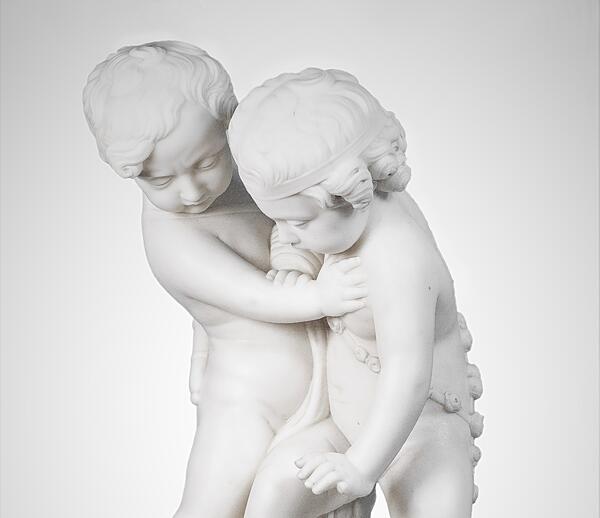The interior of Empire living rooms in the first third of the 19th century often included marble sculptures. “Cupids Fighting for the Human Heart” from the museum’s collection was made by an unknown author in the 19th century after the model of the famous French sculptor Jean Baptiste Pigalle.
Jean-Baptiste Pigalle was born in 1714 in the Parisian suburb of Rueil-Malmaison in France. He received his primary art education under the guidance of French sculptors and later moved to Italy. Pigalle specialized in neoclassicism — a style transitioning from rococo to classicism, as well as created several mythological and allegorical statues. Nowadays his works are kept in the Louvre.
Pigalle’s portrait sculptures were characterized by realism. The decorative works, on the other hand, were distinguished by their lightness, playfulness, and rich decor. They created an atmosphere of carelessness characteristic of the “gallant age”. It was such sculptures that customers wanted to see in the halls of their palaces, gardens, and gazebos.
The favorite character of the plastic arts of that era was Cupid — an allegorical symbol of love, sending arrows to the heart of a person. Artists interpreted this image in different ways, including depicting Cupid as a winged boy. This version is embodied in the sculpture “Cupids Fighting for the Human Heart”. Cupids’ wings were lost.
Before entering the museum, the sculpture belonged to the collector Boris Paryshev from Arkhangelsk: it was acquired by his father when he lived with his family in Ryazan. There is no information about the origin of the sculpture. Perhaps it was previously located in one of the estates of the Sheremetevs, the owners of the manor houses in Kuskovo and Ostankino. During a trip abroad in the 1770s, Count Nikolay Sheremetev bought furniture, decor items, and works of art.
After the revolution, items from the Sheremetev estate appeared on the antique market. In the magazine “Old Years” for 1910, there is a description of their estates near Moscow:
Jean-Baptiste Pigalle was born in 1714 in the Parisian suburb of Rueil-Malmaison in France. He received his primary art education under the guidance of French sculptors and later moved to Italy. Pigalle specialized in neoclassicism — a style transitioning from rococo to classicism, as well as created several mythological and allegorical statues. Nowadays his works are kept in the Louvre.
Pigalle’s portrait sculptures were characterized by realism. The decorative works, on the other hand, were distinguished by their lightness, playfulness, and rich decor. They created an atmosphere of carelessness characteristic of the “gallant age”. It was such sculptures that customers wanted to see in the halls of their palaces, gardens, and gazebos.
The favorite character of the plastic arts of that era was Cupid — an allegorical symbol of love, sending arrows to the heart of a person. Artists interpreted this image in different ways, including depicting Cupid as a winged boy. This version is embodied in the sculpture “Cupids Fighting for the Human Heart”. Cupids’ wings were lost.
Before entering the museum, the sculpture belonged to the collector Boris Paryshev from Arkhangelsk: it was acquired by his father when he lived with his family in Ryazan. There is no information about the origin of the sculpture. Perhaps it was previously located in one of the estates of the Sheremetevs, the owners of the manor houses in Kuskovo and Ostankino. During a trip abroad in the 1770s, Count Nikolay Sheremetev bought furniture, decor items, and works of art.
After the revolution, items from the Sheremetev estate appeared on the antique market. In the magazine “Old Years” for 1910, there is a description of their estates near Moscow:


